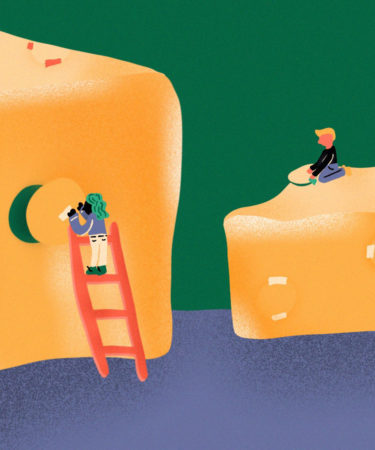When thinking of Swiss cheese, the floppy, flavorless deli slices with gaping holes may spring to mind. That cheese is an industrialized version — the wheels weigh in at a whopping 225 pounds — of the O.G. Swiss cheese Emmentaler. However, there are many other unique and delicious Swiss cheeses to enjoy. Thanks to the workings of the so-called Swiss Cheese Mafia, Switzerland’s cheese production had some issues during the 20th century. But today, cheese freedom reigns again and is, as it turns out, pretty tasty.
These are the seven Swiss cheeses to know, and what to pair with them.
Gruyère
Gruyère is a name-protected cheese that has been made since approximately 1115. Named after a town (like many old-school European cheeses), this is the Swiss cheese that you likely have melted over your French onion soup and in fondue. It’s brothy, nutty, and salty, and is typically aged between 5 and 12 months. If you see “Gruyère Vieux” or Gruyère Reserve,” they were aged longer — 18 to 24 months — and will have even more concentrated, savory umami flavor. Pair with a hearty porter to bring out the hazelnutty notes in the cheese.
L’Etivaz
Think of it as original Gruyère. In the 1930s, when the Swiss were taking steps to make Gruyère a name-protected cheese, a group of cheesemaking families felt that the new laws — meant to make Gruyère more widely accessible — compromised the quality of the cheese that they so dearly loved. So, they pulled out of Gruyère production and decided to keep making the cheese they had always made under the name L’Etivaz. Now name-protected itself, L’Etivaz is only made in the summer when the cows can graze on Alpine meadows. The cheese is made in copper kettles over an open fire, the way it was historically done. If you taste it expecting Gruyère, you’ll be shocked — it has flavors of beef broth, porcini mushroom, grilled pineapple mountain herbs, and strawberry fruit snacks. To accentuate the cheese’s herbaceousness, pair with a rustic Sangiovese.
Sbrinz
Sbrinz may just be the oldest European cheese — it’s said to have been made by the Celts since before the birth of Christ and was mentioned in official records as early as 70 AD. In fact, Sbrinz is said to be an ancestor of Parmigiano Reggiano. In the Middle Ages, Parmigiano was only made with the milk of the Swiss Brown Cow, which is the same breed used to make Sbrinz. It’s a beautiful cheese for grating, if you’d like, but also can be savored solo with a heftier red, like a Barolo. The fat content of this aged whole-milk cheese will smooth out the tannins and bring out the wine’s notes of coffee and licorice.
Scharfe Maxx
After the Swiss Cheese Union was disbanded, star Swiss cheese makers finally were able to innovate and a Swiss cheesemaking renaissance began. Scharfe Maxx is a tasty example of this — Käserei (in Swiss, “cheese house”) Studer made award-winning Appenzeller before this family-owned cheese producer started making Scharfe Maxx in 2004. It’s bacon-y, creamy, oniony and delightful on a grilled cheese sandwich. Pair with a dry martini to accentuate the oniony character even further.
Engelberg Cheddar
Cheesemaker Walter Grob wondered what would happen if he made a cheddar with the beautiful Alpine-grazed cow’s milk that he had access to. When he came to Engelberg in 2015, what is now Grob’s dairy was run by Benedictine monks and only traditional Swiss styles were made. With Engelberg Cheddar, Grob wanted to shake things up a bit and become more famous than his local ski resorts. We couldn’t tell you the name of those resorts, but the cheddar seems to be making its way ‘round the world. Try it with your favorite apple or pear cider — a fun take on the classic snack pairing of cheddar and apple slices.
Vacherin Fribourgeois
What about a Swiss cheese for fondue? Meet Vacherin Fribourgeois. It was mentioned in some of the earliest records of fondue, written about a millennium ago. Made with the milk of the local Fribourgeois cow — which in the U.S. we call Holsteins or “those black and white spotted cows” — this cheese is milky and funky, with flavors of hay and nuts. It’s excellent in fondue, certainly, but also great for snacking or for your grilled cheese sandwich. Enjoy with a white Burgundy to bring out savory custard notes.
Tête de Moine
Tête de Moine or “head of the monk” was invented around eight centuries ago in the Swiss Jura mountains. The cheese is often served in thinly shaved florets, thanks to the use of a little device called a girolle that shaves away the top layer of the cheese, leaving a sort of bald spot on the monk’s head. The cheese was mockingly named after the nearby monks by the occupying French soldiers around the French Revolution. Since the cheese has existed, it’s been used to pay rent, settle legal disputes, and as general currency. The toasty, golden apple notes in a glass of Crémant du Jura will tame the cheese’s funk and accentuate its roasted cashew character.
